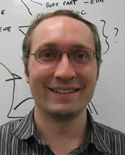
Christopher Baker, Ph.D.
Research Topics
The aim of the Unit on Learning and Plasticity is to better understand how the structure, function and selectivity of the cortex change with experience or impairment, even in adulthood. Toward this goal, there are three main avenues of research, principally using brain-imaging techniques. The first avenue concerns the nature of perceptual representations in the human brain, focusing on complex visual stimuli such as faces, bodies, scenes and words. The second avenue explores how experience and learning change the neural and cognitive representations of sensory input. For example, what are the neural changes underlying our enormous capacity to learn to recognize new objects and to make fine-grained discriminations among those objects? The third avenue concerns how the cortex adapts following damage to the nervous system (either peripheral or central). For example, what is the impact of macular degeneration (loss of foveal vision) or amputation on cortical function and how does that relate to conditions such as phantom limb pain (pain in the missing limb)? Elucidating the nature and extent of cortical plasticity is critical for understanding brain function throughout life.
Biography
Dr. Baker is Chief of the Unit on Learning and Plasticity in the Laboratory of Brain and Cognition. He received his B.A. in Neuroscience in 1995 from the University of Cambridge in England, and his Ph.D. in Psychology in 1999 from the University of St. Andrews in Scotland, where he worked with Dr. David Perrett on neurophysiological studies of visual perception. During a postdoctoral fellowship at the Center for the Neural Basis of Cognition in Pittsburgh, he worked with both Carl Olson and Marlene Behrmann on combined monkey neurophysiological and human behavioral studies of visual object representation and learning. In 2003, he moved to MIT to work with Nancy Kanwisher, using functional brain imaging techniques to investigate learning, plasticity and high-level vision in human cortex. Dr. Baker arrived at the NIMH in the fall of 2006.
Selected Publications
Wardle SG, Paranjape S, Taubert J, Baker CI (2022). Illusory faces are more likely to be perceived as male than female. Proc Natl Acad Sci U S A 119. https://doi.org/10.1073/pnas.2117413119. [Pubmed Link ]
Teichmann L, Moerel D, Rich AN, Baker CI (2022). The nature of neural object representations during dynamic occlusion. Cortex 153, 66-86. https://doi.org/10.1016/j.cortex.2022.04.009. [Pubmed Link ]
Wardle SG, Taubert J, Teichmann L, Baker CI (2020). Rapid and dynamic processing of face pareidolia in the human brain. Nat Commun 11, 4518. https://doi.org/10.1038/s41467-020-18325-8. [Pubmed Link ]
Hebart MN, Zheng CY, Pereira F, Baker CI (2020). Revealing the multidimensional mental representations of natural objects underlying human similarity judgements. Nat Hum Behav 4, 1173-1185. https://doi.org/10.1038/s41562-020-00951-3. [Pubmed Link ]
Silson EH, Steel A, Kidder A, Gilmore AW, Baker CI (2019). Distinct subdivisions of human medial parietal cortex support recollection of people and places. Elife 8. https://doi.org/10.7554/eLife.47391. [Pubmed Link ]
Magnuson Clinical Center, Room 4C216, MSC 1366
BETHESDA, MD 20814
Phone: +1 301 435 6058
Fax: +1 301 443 7111
